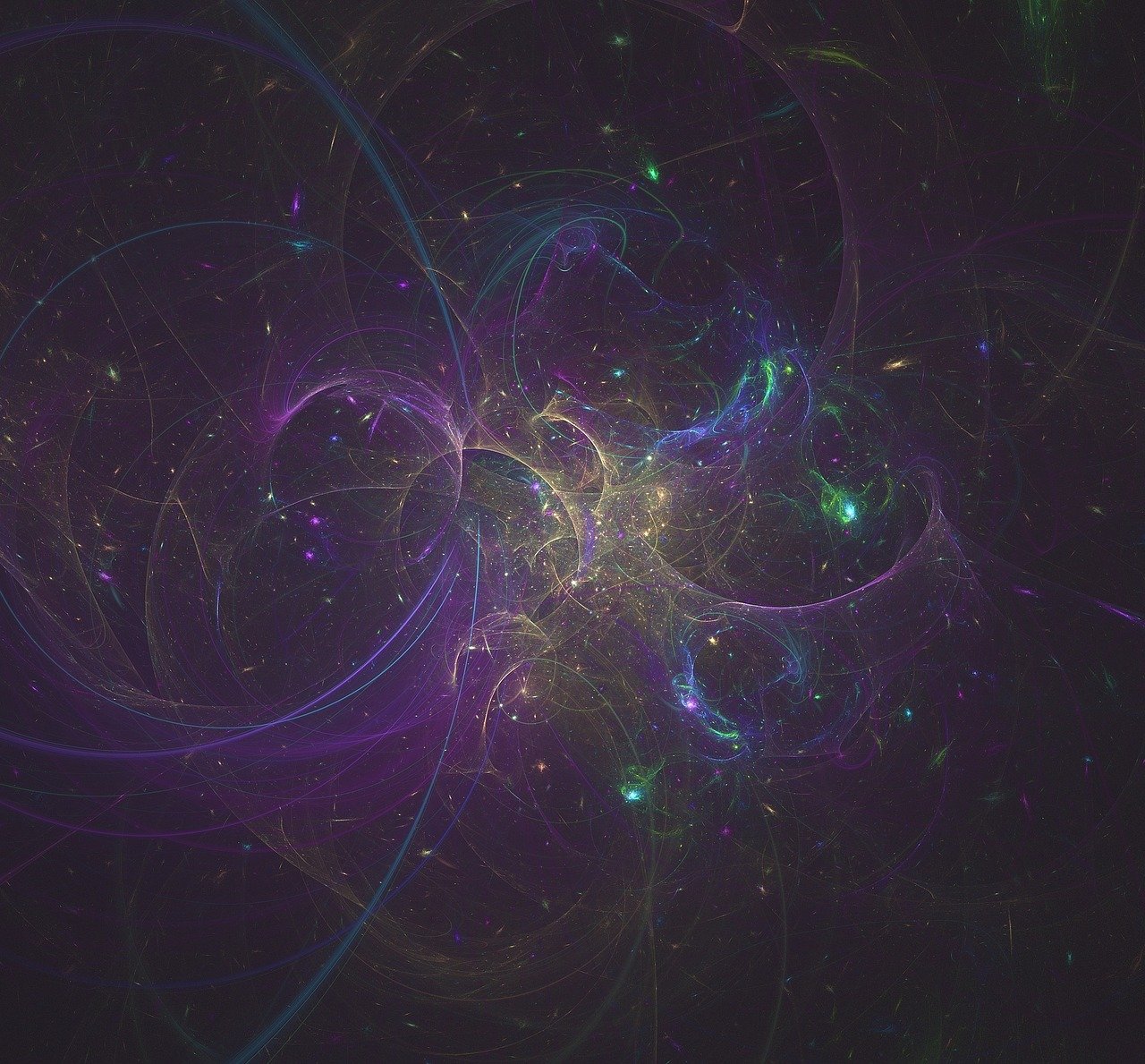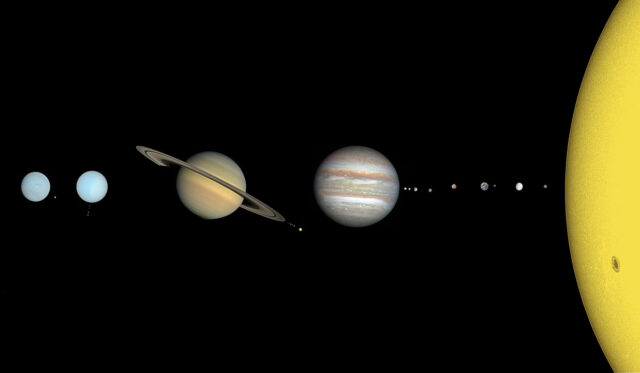“I like to say that while antimatter may seem strange, it is strange in the sense that Belgians are strange. They are not really strange; it is just that one rarely meets them.”
Lawrence M. Krauss
Everything we see is made up of different atoms and their combinations; these atoms make up the unique elements in the periodic table.
However, it is also known that even atoms are not the fundamental unit of the existence of matter.
Atoms contain subatomic particles like protons, neutrons, and electrons, which are (not fundamental and) further made up of “quirky” quantum entities called quarks.
Several more elementary particles have also been discovered in recent years, and have been stacked into what we can call a database (if you will) of particle physics – a “physical” model, encompassing all fundamental particles and forces of this universe, that we call the Standard Model of Elementary Particles.
All of these particles are responsible for the existence of all matter and forces around us.
But here’s the gist – everything that you read about so far in this article falls under what we refer to as ordinary matter.
We add the prefix “ordinary” to “matter” as it turns out that matter (or “ordinary matter”) is not the only one of its kind.
Today we talk about what is not ordinary, not matter, but still matters.
We call these entities antimatter (the name is intuitive in itself), and yes they actually do exist.
Simply put, it is called antimatter, which sounds like the opposite of matter.
So, on one hand, we have ordinary matter that is made of ordinary particles (or just particles).
On the contrary, antimatter is not ordinary matter and is made up of what we call antiparticles – the opposite of particles.
All particles have their corresponding antiparticles having opposite properties as compared to themselves. For instance, a positron is the antiparticle of an electron.
Can you now deduce why a positron has a positive charge that is the same in magnitude as that of an electron?
Antimatter is essentially matter composed of antiparticles of their corresponding (ordinary) particles present in ordinary matter.
Similar to a positron there are many more antiparticles.
You can distinguish them by their negative baryon number since ordinary particles have positive baryon numbers.
But before we move any further, we first need to be aware of what makes antimatter different from ordinary matter.
You must have learned in school that anything that occupies volume and has mass can be termed matter.
However, this description of matter is inadequate to understand the difference between matter and antimatter.
But hold on, we still have common grounds, antimatter also has mass and occupies volume.
So, what’s “anti” about antimatter?
Difference Between Matter and Antimatter?
The only thing that differentiates matter from antimatter is the constituent particles.
Earlier in this article, we discussed that matter is made up of particles whereas antimatter is made up of antiparticles.
This leads us to the real fundamental question: What is the difference between particles and antiparticles?
For that, we need to have a good look at the Standard Model of Elementary Particles (we’d recommend you to read a little about the same before moving on), which consists of two families of particles – fermions and bosons.
Fermions, such as electrons and quarks, make up matter as we see them, while bosons, like W and Z bosons, are the carriers (literally) of fundamental forces.
Generally speaking, everything in this universe is made up of fermions, whereas bosons are responsible for all the forces in this universe.
Fermions abide by the laws of Pauli’s exclusion principle which says – “two or more fermions cannot occupy the same quantum state within a quantum system simultaneously” or simply, “two fermions cannot occupy the same space at the same time.”
As far as mass is concerned, fermions “get” their mass by interacting with the Higgs Field – a quantum field that imparts mass to particles by the laws of quantum field theory (let’s not jump into that though for obvious reasons).
This is what gives the matter a familiar definition of something that occupies space and has mass.
Now, every fermion that exists in the standard model has its corresponding antiparticle.
Antiparticles have a mass similar to their corresponding particle (or counter particle) but have opposite quantum properties such as opposite charges, baryon number, and lepton number.
Reconsidering a positron (the antiparticle of an electron), it has a similar mass but is positively charged.
Similarly, a proton is made up of quarks while an antiproton is made up of antiquarks and has the same mass but opposite charge.
So strictly speaking, antimatter is not entirely the opposite of matter. It is just another type of matter which has opposite quantum properties.
The difference is that, just like ordinary particles bind together to form matter, antiparticles bind together to form antimatter.
For example, an anti-hydrogen atom is composed of antiprotons and positrons.
Similarly, there exists antimatter for every other element in the periodic table, all we’ve to do is to replace ordinary particles with their counterparticles, or antiparticles.
Basic Particles and Their Antiparticles
| Particle | Antiparticle |
|---|---|
| Electron | Positron |
| Proton | Antiproton |
| Neutron | Antineutron |
| Muon | Antimuon |
| Tau | Antitau |
| Up Quark | Anti-Up Quark |
| Down Quark | Anti-Down Quark |
| Charm Quark | Anti-Charm Quark |
| Strange Quark | Anti-Strange Quark |
| Top Quark | Anti-Top Quark |
| Bottom Quark | Anti-Bottom Quark |
| Gluon | Antigluon |
| W+ Boson | W- Boson |
| Z Boson | Z Boson |
| Photon | Photon |
| Higgs Boson | Higgs Boson |
How Was Antimatter Discovered?
British physicist Paul Dirac was the first to theorize antimatter in 1928.
While he was solving the Dirac equation (a relativistic quantum wave equation formulated by him) for an electron, he realized that it can have two sets of solutions[1].

One set gave a solution with positive energies while the other set gave a solution with negative energies.
This bewildered Dirac at first and he thought that he must’ve miscalculated the math (spoiler alert… he did not).
It was posed that the solution corresponding to negative energy must be a new form of matter which was had not been discovered yet.
Later, it came to him that the “new form of matter” was but an antiparticle.
He figured out that antimatter can have the same properties as ordinary matter (as already discussed).
So, if you have an apple that is made up of antiparticles, it would still look the same as an ordinary apple.
Warning: Do not bring the “anti-apple” near an “ordinary apple”. Otherwise, an apple a day would not leave you alive to keep the doctor away.
Dirac was not the first to conceptualize antimatter though, the term was first used by German-British physicist Arthur Schuster in 1898 who hypothesized antiatoms.
However, it was nothing more than an abstract idea with no solid theoretical explanation or accountability.
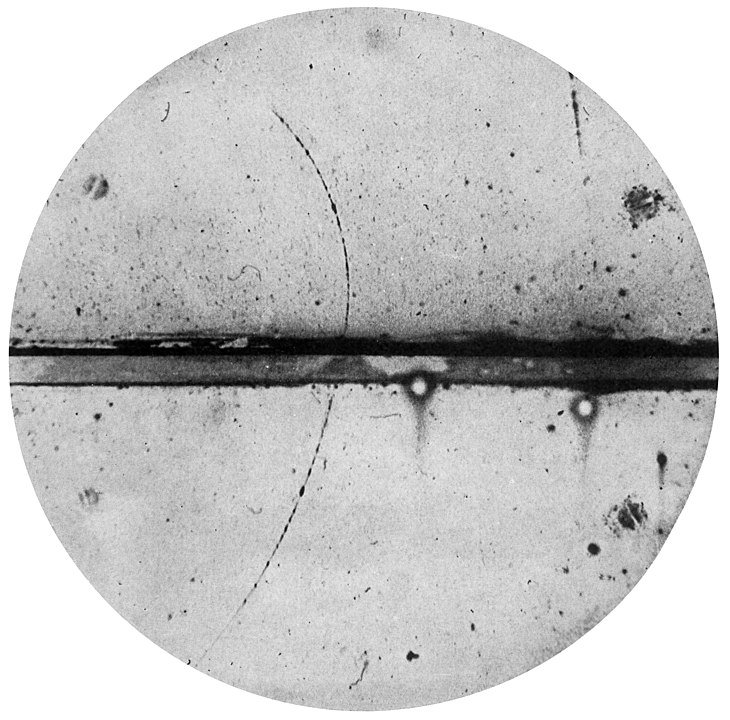
In 1932, Carl D. Anderson discovered antimatter for the first time – he discovered a positron swirling around in a cloud chamber.
It was tracing a path opposite to an electron despite having many of its properties similar to an electron, which was a bit strange for practical observation.
What is Antimatter Annihilation?
We are simply asking here what happens when we try to combine matter and antimatter.
Annihilation is the interaction between matter and its corresponding antimatter, or a particle and its antiparticle, giving off pure energy or radiation.
A merge between a particle and its antiparticle leads to their mutual annihilation – an outburst-like phenomenon emitting particles such as intense photons, neutrinos, or even less massive particle-antiparticle pairs, in varying proportions.
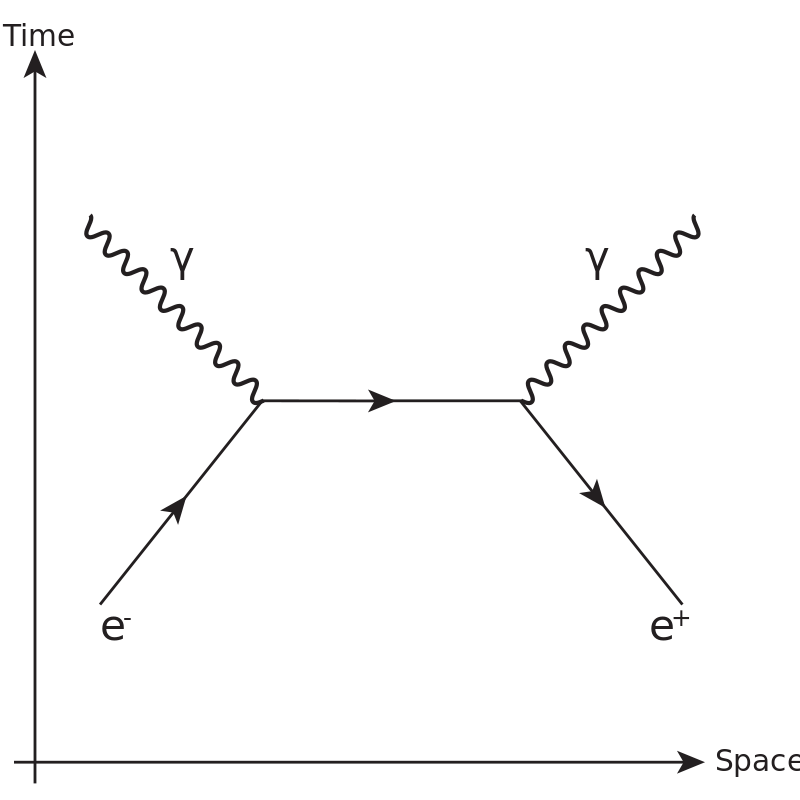
Most of the energy from annihilation is in the form of radiation, in the presence of surrounding matter, the radiation is converted into other forms of energy, such as heat and light.
So, is it possible to calculate the amount of energy released during annihilation?
It can be calculated using Einstein’s famous mass-energy equivalence equation: $E=mc^2$ which means the released energy would be equal to the mass that disappeared multiplied by the speed of light squared.
Consider an electron-positron annihilation; when an electron and a positron collide at low energies, two gamma photons are released with a total energy of 1.02 MeV.
Here a particle-antiparticle pair annihilates to create a pair of gamma photons (or pure radiation).
Thus, the electron-positron annihilation reaction is also called pair annihilation – the reverse process of pair production.
Given the information above, can you figure out what would happen in pair production?
Now suppose you bring two apples, of 300 grams each, to contact where one apple is composed of matter and the other constitutes antimatter.
So, the total energy released during their annihilation would be equal to (3×108)2, which equals 2.7 times 1016 joules of energy.
Fact: To put you under perspective, the atomic bomb dropped on Hiroshima released about 1.5×1013 joules of energy. That is only 0.05% of the energy released above by our cute little apples.
Matter-Antimatter Asymmetry – Baryon Asymmetry
Let’s face the truth: we live in a world that is made up of matter, not antimatter.
Why though? If there exists antimatter so gloriously, where is all of it?
It turns out that most of the observable universe is made up of ordinary matter only, and not equal amounts of both types.
This gave rise to the idea of what is known as baryon asymmetry, also known by other names like matter-antimatter asymmetry problem and matter-antimatter discrepancy.
It is believed to be one of the biggest problems in physics to date.
Physicists suggest that an equal amount of matter and antimatter particles must have been created when the universe was born, but the apparent nature of the world implies otherwise.
Some theorize that during the creation of the universe i.e. following the Big Bang, matter and an equal amount of antimatter resulted in annihilating each other (just the way they usually do).
But somehow ordinary matter gained precedence over antimatter.
We don’t know what caused that, but whatever it is, it is the reason why we exist in the first place.
Everything that exists as matter, from the gigantic stars and galaxies to you (who’s reading about antimatter itself) is because the antimatter (for some reason) could not counterbalance ordinary matter, and left some of it, only for us to take birth and study it after billions of years.
Although the reasons are not known, several hypotheses attempt to justify this asymmetry.
None of them have yet been proven but one of them is very popular – baryogenesis.
Baryogenesis is hypothesized as a physical process to have taken place in the very early phase of our universe, which produced an imbalance in the numbers of matter and antimatter particles.
This particular imbalance was due to the creation of more ordinary matter over antimatter.
But theoretically, this imbalance had to be extremely small (thus becoming the matter that we see today).
Fact: As a matter of fact, or should I say fact of matter, about 1 extra particle of matter, in 1,630,000,000 (1.6 billion) annihilated particles, is what our stars and galaxies are made up of.
So, the world that exists around us is but the leftover of a cosmic process fractions of seconds after the Big Bang.
Does that mean, there is no antimatter left?
Is it possible for antimatter to occur in this universe anyhow?
Is Antimatter Real – How is Antimatter Created?
We now want to ask—how is antimatter created, and can we create antimatter?
Antimatter is the rarest thing to occur in this universe, it is so rare that we have to artificially manufacture it in factories.
Its rarity and highly unstable behavior with ordinary matter make it the most expensive substance on the planet.
What is the Cost of Manufacturing 1 gram (1g) of Antimatter?
According to NASA, the cost of producing one gram of antihydrogen (the antiparticle of hydrogen) would be $62.5 trillion[2].
The creation of antiparticles occurs as a result of the collisions of high-energy particles.
High-energy cosmic rays, which affect matter, produce minute quantities of antiparticles that get annihilated as soon as they make contact with ordinary matter.
Gamma-ray can also be converted into a pair of an electron and positron via a process called pair-production.
The process of pair production needs to satisfy the conservation of momentum and energy since it cannot occur in free space for the given reason, it usually happens in the vicinity of a nucleus.
The energy of gamma-ray is completely converted into mass, so it is a classic example of the mass-energy equivalence relation.
β+ decay, which is a type of radioactive decay, also emits a positron.
In the β+ decay process, a proton, inside a radionuclide, decays into a neutron while giving off a positron and an electron neutrino.
The detection of short gamma bursts in the universe like in the center of galaxies (or similar places with high-energy particle interaction) solidifies the presence of positrons.
These bursts are created at these places because of the annihilation of the ordinary matter around them.
Not just that but even on Earth, antiparticles are naturally created when energetic particles from cosmic rays interact with molecules in the atmosphere.
Fact: The first positron, discovered by Carl D. Anderson, came from the atmosphere interacting with cosmic radiation.
The instability in antiparticles due to their tendency to annihilate with ordinary matter is what makes them the rarest particles in the universe.

Besides natural existence, antiparticles can also be produced artificially in labs, CERN (European Council for Nuclear Research) has a lab that produces antimatter.
Yes, the most expensive substance in this universe is being brewed in laboratories.
At CERN, antiparticles are created to study their behavior and interactions with other particles and antiparticles.
However, the antiparticles created are hard to trap because of their immense instability, and they end up annihilating inside the detectors.
To counter this, CERN produces slow antiprotons that can be trapped and stored to be studied later.
The coolest part of research about antimatter is that it’s being tested for having anti-gravitational properties, all major tests and experiments are being conducted at CERN.
Studying matter-antimatter and antimatter-antimatter interactions is extremely interesting and significant, but its annihilating nature, and storage tantrums, create a few problems.
Eventually, everything (be it the machinery or the container) is made up of ordinary matter. Thus, antimatter cannot be contained in normal containers as it would annihilate upon making contact.
Keeping this in mind, antimatter (in the form of charged particles) is contained by a combination of electric and magnetic fields, in a device called a penning trap.
Does Antimatter Travel Backwards in Time?
One of the most interesting questions about antimatter is– does antimatter travel backward in time?
Read it again and you shall find that it is not so hard to actually believe that it might travel backward in time.
However, the nature of antimatter does not necessarily imply that it is moving backward in time, as our existing perceptions of the nature of time would likely suggest.
Let us take an example: Consider the Compton scattering of an electron.
In this interaction, a highly energetical photon (massless particle) collides with an electron, which is at rest.
Consequently, the photon deviates from its initial path and emerges out at an angle, whereas the electron, having absorbed the (lost) energy of the photon, gains momentum and emerges at a particular angle (meaning it does not go along the line of the initial motion of photon).

This phenomenon is also known as the Compton Effect.
The Compton effect can be represented by the following equation:
e + γ → e* + γ*
On the right-hand side of the equation, e* represents the emerging electron, which has gained some energy, while γ* represents the deviated photon (which has now lost some of its energy).
Here e represents the electron, which is initially at rest and y represents the incoming photon.
Now, we can exchange the positions of electrons and photons in the given equation like this:
e + ē → γ° + γ
Here, the left side of the equation represents the particle before the interaction, while the right side represents after the interaction.
According to the crossing symmetry, moving any particle to another side of the equation converts that particular particle into its counter-particle (as depicted in the above example).
The above interaction looks like the annihilation of the electron-positron pair (ē is positron which was an electron on another side of the equation previously) as we can see the energy being released on the right side in the form of two photons.
Hence, both of the interactions look similar but the electron which was moving away in the Compton Effect behaves similarly to the positron approaching the electron for annihilation.
In such equations, both the particles act in very opposite ways (mathematically), which seems as if both particles are moving in opposite directions in time.
However, many physicists don’t agree with the fact that matter moves backward in time to behave like antimatter in the way we might imagine.
For further insights, you may follow this intuitive YouTube video by “Parth G” explaining antiparticles and their relation with time – Do Antiparticles Move BACKWARDS in Time?[3].
What Can Antimatter Be Used for?
Sci-fi series like Star Trek featured antimatter as fuel used in warp drive engines on spaceships and the movie Pandorum (2009) featured a spaceship that uses an antimatter reactor.
Have you ever imagined whether those are real?
Well, science fiction has made the concept of antimatter to be very exotic stuff that can power engines for a long time or a weapon capable of destroying planets.
It might seem fictitious, yet somehow, these concepts are not as hoaxed as they sound.
Antimatter Applications in Medical Imaging
Matter-antimatter interactions have found their use in medical imaging like Positron Emission Tomography (PET).
PET uses positron-emitting radioisotopes, which are attached to sugar or glucose used by the body.
Positrons radiating from the sugar can be detected by detectors and we can obtain an image of the body highlighting the parts with higher metabolism.
Antimatter Propulsion Systems for Space Travel
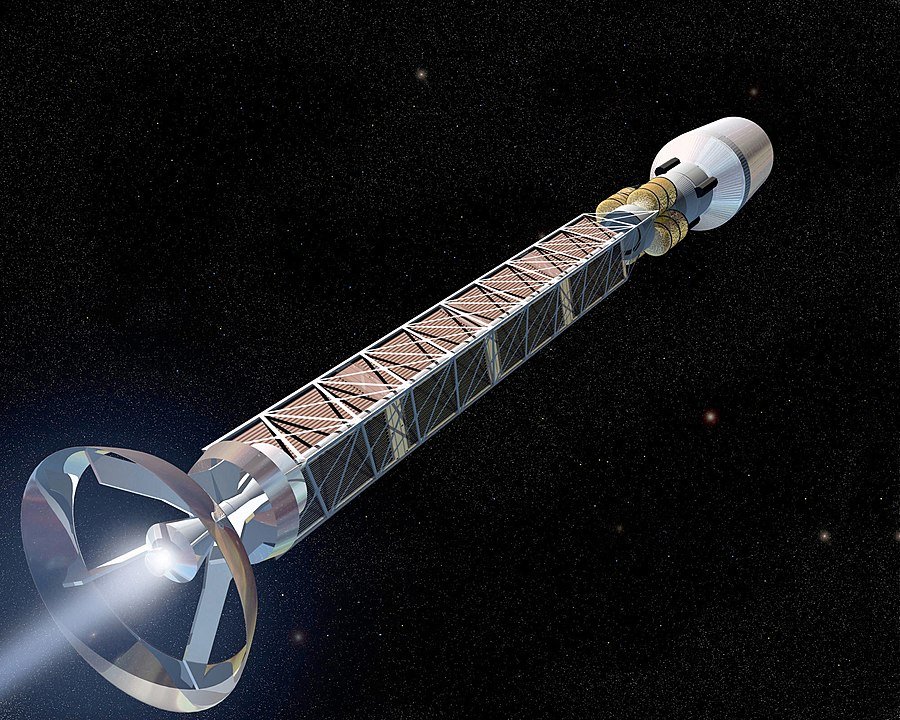
Currently, we are both technologically and economically incapable of full-fledged space travel, and one of the biggest reasons for the same is the efficiency and type of fuel we use.
With so much discussed already, you are now well aware of antimatter and its behavior with the matter.
The use of antimatter seems quite promising as it gives off a humongous amount of pure energy, more than any ordinary fuel that we have ever could.
It can be a potential fuel for interplanetary travel (yes, you read that right), as isolated and stored antimatter can be used in antimatter-catalyzed nuclear pulse propulsion rockets.
Sounds cool, doesn’t it?
Even antimatter-fueled spacecraft will have a higher thrust-to-weight ratio than normal crafts due to antimatter fuels being much denser.
Antimatter Bomb vs Tsar Bomb
Just 1 kilogram of matter and antimatter can combine to emit energy equivalent to 43 megatons of TNT, which is as much as the energy caused by an explosion of the Tsar Bomb (50 megatons of TNT), weighed about 27000 kilograms (the amount of fuel used in Tsar was never disclosed) – the largest thermonuclear weapon ever detonated.
This is the reason why not all energy produced can be used for propulsion (as of now) since annihilation comes into effect.
The electron-positron reactions result in gamma-ray photons, which are difficult to direct and use for thrust.
Dreadful Possibility of Antimatter Weapons
However, just like anything powerful, antimatter can be used for ill intentions too, History tells us that nuclear science and breakthroughs have been weaponized before.
Similarly, any source of immense energy can be used for personal or national gain, even if it’s incredibly expensive to make, and the after-effects of weaponizing it will not be pleasing.
Just like any powerful technology, antimatter can also be used for hostile purposes, much like how nuclear power has been weaponized before.
The establishment of nuclear-powered technologies, in fact, is attributed to World War II.
A cinematic example can be found in the 2013 film Ender’s Game, where the ‘Doctor Device’ or ‘Molecular Disruption Device (MDD)’ is a weapon that uses a form of matter-antimatter reaction to cause a chain destruction effect at the molecular level.
Once the device hits its target, it triggers a reaction that continues to spread, disintegrating matter until there’s nothing left in a certain radius.
The device is employed as a last-resort weapon to wipe out the enemy Formic fleet and their homeworld.
In the realm of scientific speculation, antimatter could theoretically be used in a variety of weapon systems.
For instance, antimatter-catalyzed nuclear pulse propulsion, a topic discussed in advanced propulsion research, could be weaponized to launch projectiles at incredible speeds in a space warfare scenario.
Another theoretical application is small-scale tactical weapons, where the annihilation of a small amount of antimatter and matter could release energy equivalent to a large conventional bomb, though with much less material required.
It’s worth noting that these applications remain theoretical, as the containment of antimatter poses a significant challenge and any leak would lead to immediate detonation upon contact with regular matter.
Any source of such immense energy can be used for personal or national gain, even if it’s incredibly expensive to produce, and the after-effects of weaponizing it will not be pleasing.
Future of Antimatter Applications
The reason why applications of antimatter are so impractical is due to the scarcity of antimatter itself.
Fact: Fermilab is the largest producer of antimatter in the world, yet they produce only about 1 milligram (mg) of antimatter every year[4].
Antimatter is very expensive, difficult to produce, and even more difficult to store, so, there is still time for us to explore various applications of antimatter.
That tells us enough about how antimatter research is important to us from both technological and scientific points of view.
Studying antimatter interactions can help us understand the universe to its fundamental levels, and remember the matter-antimatter asymmetry problem?
Maybe someday we could understand why matter took precedence over antimatter.
Scientists have found out that even though antimatter exhibits the same physical properties as matter, some antimatter interactions are different from their matter counterparts[5].
We do not yet know why that happens.
All we know is that there is a discrepancy in the matter-antimatter symmetry so it could mean that there is something new, waiting to be discovered.
Today, there are many global labs equipped with state-of-the-art technology, for researching and studying antimatter, such as CERN, Fermilab, Japanese KEK laboratory, and Stanford Linear Accelerator Center.
Cutting-edge scientists, in various groups, are working in this field day and night, trying to unmask what’s present yet unseen.
It wouldn’t be unfair to say that these scientists are no less than explorers of the universe and the fate of our understanding of physics depends upon the results of such experiments.
Today, even after having come so far, our journey in the cosmos is still apparently unending.
Frequently Asked Questions on Antimatter (FAQs)
Is Antimatter and Dark Matter the Same?
No, it’s not, dark matter and antimatter are both different.
A major difference between dark matter and antimatter is that antimatter interacts with matter while dark matter doesn’t interact with matter at all, but only with gravity.
Does a Photon Have its Antiparticle?
Technically it does, photons belong to the category of bosons which have no charge and do not follow Pauli’s exclusion principle.
So, photons are considered their own antiparticle.
Does the Universe Have More Matter than Antimatter?
The universe had created equal amounts of matter and antimatter, and “apparently” there does not seem any antimatter around, but that is way too little information to conclude the precedence of antimatter.
Antimatter has the same properties as matter, so there might be an entire galaxy of antimatter and we wouldn’t even know.
How Does Antimatter Interact with Gravity?
Antimatter interacts with gravity the same as ordinary matter does.
Since gravity is caused by mass, antimatter would attract any other mass, whether it’s matter or antimatter.
There is no repulsion between matter and antimatter as it would violate the CP symmetry.
References
- ‘Antimatter‘, CERN, “Paul Dirac wrote down an equation (…) can have two possible solutions”[↩]
- ‘Reaching for the Stars‘, NASA, 12 April 1999, “Right now, antimatter is the most expensive substance on Earth, about $62.5 trillion a gram ($1.75 quadrillion an ounce).”[↩]
- Parth G, ‘Do Antiparticles Move BACKWARDS in Time?‘, Parth G (Youtube), 30 May 2022[↩]
- Kurt Riesselmann, Physics Questions People Ask Fermilab, Fermilab, 28 April 2014, https://www.fnal.gov/pub/science/inquiring/questions/antimatter3.html[↩]
- Kurt Riesselmann, Physics Questions People Ask Fermilab, Fermilab, 28 March 2014, “Scientists use the antimatter to study its properties and composition (…) Surprisingly, they have found that some interactions between antiparticles are slightly different than the same interactions between the corresponding particles.”[↩]
